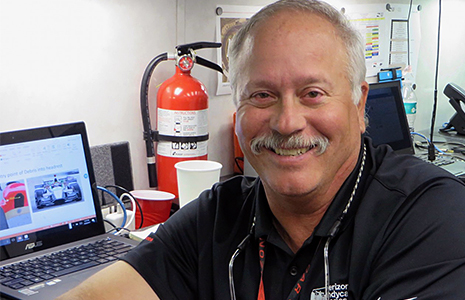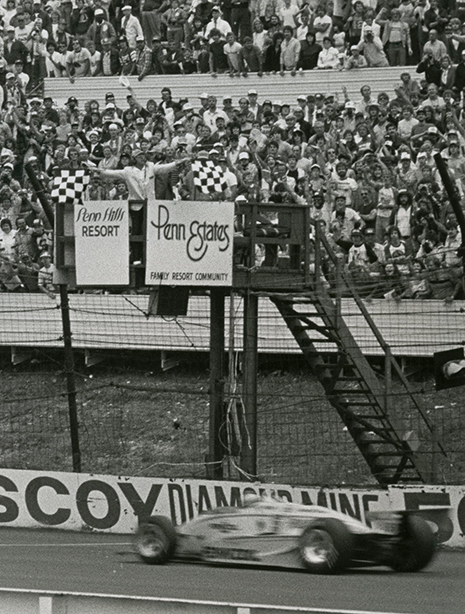(This story originally appeared as exclusive content on the Verizon INDYCAR Mobile app. To download the app for use on smartphones, click here.)
For Indy car legend Rick Mears, Pocono Raceway – site of this weekend’s ABC Supply 500 – has special meaning.
It’s the track where the four-time Indianapolis 500 winner confirmed his racing return from devastating foot injuries a year earlier to win the 1985 event at the 2.5-mile oval.
Mears crashed during an Indy car practice session on Sept. 7, 1984, at Sanair Speedway in St. Pie, Quebec. The nose of the car was wedged underneath the mangled guardrail on the frontstretch of the Canadian short oval, crushing Mears’ feet.
Canadian doctors told team owner Roger Penske and Dr. Steve Olvey, then the head of the series’ medical and safety team, that amputation was the only option.
“At the hospital in Sanair, Quebec, they said they were going to have to amputate both feet because there wasn’t anything they could do with them,” Mears told the Verizon INDYCAR Mobile app. “Roger Penske and Dr. Steve Olvey were standing there when the doctors told them that and they said, ‘Timeout, we’re going to try something else.’”
 Olvey contacted a young doctor in Indianapolis who had already gained notoriety for saving the legs of driver Danny Ongais after his pounding crash in Turn 3 of the 1981 Indianapolis 500. Dr. Terry Trammell is the man who saved Mears’ career.
Olvey contacted a young doctor in Indianapolis who had already gained notoriety for saving the legs of driver Danny Ongais after his pounding crash in Turn 3 of the 1981 Indianapolis 500. Dr. Terry Trammell is the man who saved Mears’ career.
“I owe my feet to Dr. Trammell, so all of my career from 1984 on, he is a big part of. And to Roger Penske for getting me to Trammell,” said Mears, who collected the last 10 of his 29 career wins – including two Indianapolis 500s – after recovery from the injuries.
Trammell, now INDYCAR’s medical safety consultant (shown at right), recalled the extent of Mears’ injuries.
“I went up to Montreal and that whole thing was surreal from the call to go to getting there to deal with the authorities,” Trammell said. “I found out later the Premier of Quebec was a friend of Roger Penske’s, so we got whatever we wanted or needed. Everything went smooth as silk to get him loaded up and back to Indianapolis.
“His feet were like beanbags. They were just mush.”
As team owner Penske worked with Canadian authorities to expedite Mears’ return to Indianapolis, Olvey organized a medical helicopter to transfer Mears to Penske’s private jet.
“I only remember bits and pieces,” Mears recalled. “I remember laying out on the rail on the skid of the helicopter like on a M*A*S*H unit you see on TV with a sheet over me, flying me out someplace to meet an ambulance to get me through different borders to get me to Roger’s plane to get me to Indianapolis.
“Meantime, Roger located Trammell. He spent all night piecing my feet back together.”
Trammell is regarded as the first orthopedic surgeon to use reconstructive hand surgery techniques on the feet. Because there was such significant damage to the bone structure, the vascular system and tissue damage, Trammell compared the Mears surgery to repair the bone fragments like “stringing beads.”
“We had to work around to get them to look like feet,” Trammell remembers. “There was skin loss and vascular issues. Everything back then was so new. There was a vascular graft where we took skin from one part of the body and grafted it somewhere else.
“There weren’t a lot of places in the country that were doing that.”
 Even after the laborious surgery was completed, Trammell feared circulation issues would prevent the soft tissue from healing. He was so distraught that he returned home and took his frustrations out on his newly-remodeled kitchen.
Even after the laborious surgery was completed, Trammell feared circulation issues would prevent the soft tissue from healing. He was so distraught that he returned home and took his frustrations out on his newly-remodeled kitchen.
“I started throwing whatever I could get my hands on in my kitchen,” Trammell recalled. “I thought for sure we were going to have to still amputate Rick’s right foot.”
But the procedure worked. Mears began to get the proper blood flow to his injured feet. Miraculously, seven months after the crash, he was testing an Indy car again for Team Penske. He arrived at Indianapolis Motor Speedway on crutches in May 1985 and qualified 10th for the Indianapolis 500. He finished 21st in the race due to a throttle linkage failure in the race won by teammate Danny Sullivan.
On Aug. 17, 1985, Mears won the pole for the 1985 Domino’s Pizza 500 at Pocono. The next day – 32 years and one day ago – Mears led 36 laps and scored his first win since the crash in Quebec. (He is shown at right taking the checkered flag.) It remains one of the most important victories of his glorious career.
“If I have to put any win other than Indy close to Indy, it would be the 1985 Pocono win after my accident in 1984,” Mears admitted. “It was my first win since the accident. That win meant a lot.
“It was where I could stamp in concrete in my mind that we are back. You always wonder how long it is going to take to get the rust off because, when you are laid up, everyone else is still progressing. You not only want to get back to where you were, you want to get back to where they are.”
Mears won the Indy 500 in 1988 and ’91 before retiring following the 1992 season. When he announced his retirement at the Team Penske Christmas party in 1992, he was just 41. He is one of only three drivers to win the Indianapolis 500 four times and holds the record for Indy 500 poles with six. He also won three season championships under CART sanction.
Now 65 and a driving coach and spotter for Team Penske, Mears admits to daily pain in his feet. He can often be seen in the paddock wearing sandals to lessen the intensity.
“But I wouldn’t trade it,” he added. “They can hurt all they want – they are both there. If they weren’t hurting, I would be nervous because they wouldn’t be there. They can hurt all they want.
“When you love what you are doing, the reward outweighs the risk. To be as fortunate as I have to be able to do what we have done, to meet the people that we’ve met and work with the people we have and the opportunities we have had, I will deal with the pain. It was well worth it as far as I’m concerned.”